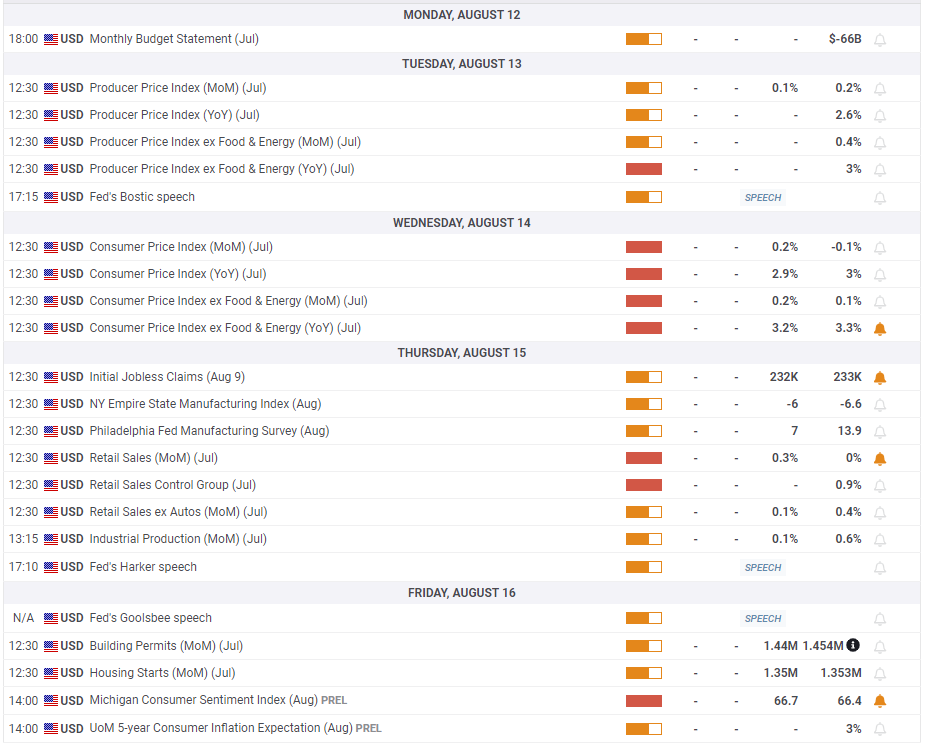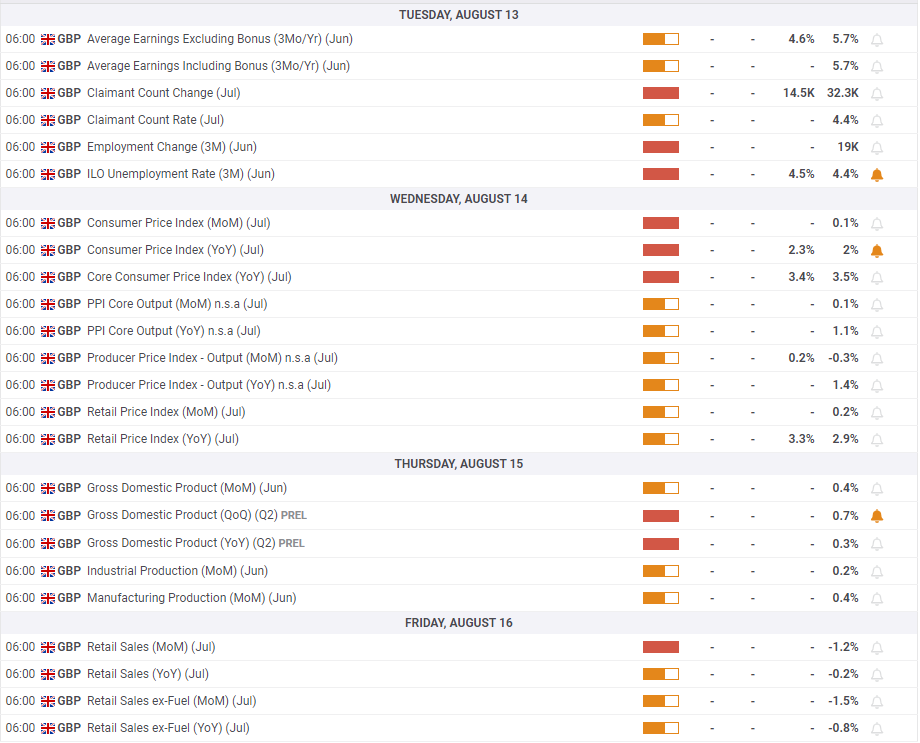- The Pound Sterling extended its losing streak to reach five-week lows against the US Dollar.
- GBP/USD braces for top-tier UK and US inflation data in the upcoming week.
- The outlook remains for an extended Pound Sterling recovery while the 200-day SMA holds.
The Pound Sterling (GBP) extended its downside momentum against the US Dollar (USD), dragging GBP/USD below the 1.2700 mark before buyers jumped back in the game toward the end of the week.
Pound Sterling pounded but buyers re-emerge
GBP/USD emerged as a tale of two halves, as it extended the previous week’s losing streak in the early part of the week only to stage an impressive comeback in the second half. This time around, the primary driver behind the Pound Sterling’s price action was risk sentiment, which significantly impacted the higher-yielding currency.
Risk-off flows extended into the weekly opening on Monday, in the aftermath of Friday’s weak US labor market report, which rekindled US recession fears. Nonfarm payrolls increased by 114,000 jobs last month after rising by a downwardly revised 179,000 in June, the US Bureau of Labor Statistics (BLS) said on Friday. The Unemployment Rate climbed to 4.3% from 4.1% in June.
Mounting US economic slowdown concerns prompted markets to wager aggressive US Federal Reserve (Fed) easing this year. Markets predicted 115 basis points (bps) of cuts this year while pricing in a 74% chance of the Fed lowering rates by 50 bps in September on Monday, according to the CME Group’s FedWatch tool.
Risk-aversion heightened also after US Secretary of State Tony Blinken during the G7 meeting on Sunday that an attack by Iran and Hezbollah against Israel could start as early as Monday, Axios reported, citing three sources.
Subsequently, US and Arab leaders tried to diffuse the situation between Iran and Israel. Meanwhile, the US and Japanese officials provided assurances to calm nerves after Monday’s bloodbath across the financial markets. However, traders remained anxious due to the looming risks of an Iran-Israel war.
Citing two sources familiar with intelligence on the matter, CNN News reported late Wednesday that Hezbollah appears increasingly set to act against Israel “independent” of an expected Iranian response to the recent killing of two terror leaders. According to CNN, multiple officials say Iran seems to still be hashing out its retaliation plans.
Geopolitical tensions combined with ‘US hard-landing fears’ continued to act as a headwind to the GBP/USD pair, knocking it down to fresh five-week lows of 1.2665.
In the latter part of the week, risk sentiment witnessed a dramatic turnaround following the release of the surprisingly strong US weekly Jobless Claims data.
Initial claims for state unemployment benefits fell 17,000 to a seasonally adjusted 233,000 for the week ended August 3, the Labor Department said on Thursday, August 8, the largest drop in about 11 months, suggesting the gradual softening in the labor market remains intact while calming markets nerves over a potential US recession.
Meanwhile, conciliatory remarks from Richmond Fed President Thomas Barkin and Chicago Fed President Austan Goolsbee also added to the market optimism. The Pound Sterling capitalized on the return of risk appetite and rebounded firmly against the US Dollar to retest the 1.2800 threshold.
Hotter-than-expected Chinese inflation data and dovish remarks from Kansas City Fed Chief Jeffrey Schmid accentuated the risk recovery and helped the pair extend its recovery momentum. The monetary policy divergence between the Bank of England (BoE) and the Fed also returned to the fore ahead of next week’s critical inflation data from the UK and the US.
The week ahead: High-impact UK and US data to steal the show
Following a data-sparse week, Pound Sterling traders strap themselves for a raft of top-tier economic data releases from both sides of the Atlantic.
The main highlight of the week will be the Consumer Price Index (CPI) data due from the US and the UK on Wednesday. In the meantime, Fedpeak, UK employment data and the US Producer Price Index (PPI) data will entertain traders in the early part of the week.
On Thursday, the UK preliminary Gross Domestic Product (GDP) report for the second quarter will be published alongside the monthly print and the Manufacturing Production data. The US calendar will feature the Retail Sales report, the usual weekly Jobless Claims and the Industrial Production data, on the same day.
The UK Retail Sales data and the US University of Michigan (UoM) preliminary Consumer Sentiment and Inflation Expectations data on Friday will wrap up an action-packed week.
Apart from the data, all eyes will be on the Middle East geopolitical escalation between Iran and Israel and also on the speeches from Fed policymakers.
GBP/USD: Technical Outlook
GBP/USD remained at the mercy of sellers and extended the downside break of the rising trendline support, then at 1.2835.
However, Pound Sterling buyers continued to defend the key 200-day Simple Moving Average (SMA) at 1.2660.
Looking ahead, the pair could see the extension of the recovery but it could be limited so long as the 14-day Relative Strength Index (RSI) stays below the 50 level.
Currently, the leading indicator is trading near 45.0, suggesting that GBP/USD appears to be a ‘sell the bounce’ trade.
Therefore, recapturing the 50-day SMA at 1.2787 on a weekly closing basis is critical to unleashing further recovery.
Further up, the 21-day SMA at 1.2858 could challenge the bearish commitments. The next topside barrier is seen near the 1.2900 region, where the March 8 high and the rising trendline support-turned-resistance coincide.
On the flip side, sellers need to crack the 100-day SMA and 200-day SMA confluence zone between 1.2670 and 1.2660 on a sustained basis to open the door for further downside.
The June low of 1.2613 and the mid-May low at around 1.2510 will be next on sellers’ radars.
Pound Sterling FAQs
The Pound Sterling (GBP) is the oldest currency in the world (886 AD) and the official currency of the United Kingdom. It is the fourth most traded unit for foreign exchange (FX) in the world, accounting for 12% of all transactions, averaging $630 billion a day, according to 2022 data. Its key trading pairs are GBP/USD, aka ‘Cable’, which accounts for 11% of FX, GBP/JPY, or the ‘Dragon’ as it is known by traders (3%), and EUR/GBP (2%). The Pound Sterling is issued by the Bank of England (BoE).
The single most important factor influencing the value of the Pound Sterling is monetary policy decided by the Bank of England. The BoE bases its decisions on whether it has achieved its primary goal of “price stability” – a steady inflation rate of around 2%. Its primary tool for achieving this is the adjustment of interest rates. When inflation is too high, the BoE will try to rein it in by raising interest rates, making it more expensive for people and businesses to access credit. This is generally positive for GBP, as higher interest rates make the UK a more attractive place for global investors to park their money. When inflation falls too low it is a sign economic growth is slowing. In this scenario, the BoE will consider lowering interest rates to cheapen credit so businesses will borrow more to invest in growth-generating projects.
Data releases gauge the health of the economy and can impact the value of the Pound Sterling. Indicators such as GDP, Manufacturing and Services PMIs, and employment can all influence the direction of the GBP. A strong economy is good for Sterling. Not only does it attract more foreign investment but it may encourage the BoE to put up interest rates, which will directly strengthen GBP. Otherwise, if economic data is weak, the Pound Sterling is likely to fall.
Another significant data release for the Pound Sterling is the Trade Balance. This indicator measures the difference between what a country earns from its exports and what it spends on imports over a given period. If a country produces highly sought-after exports, its currency will benefit purely from the extra demand created from foreign buyers seeking to purchase these goods. Therefore, a positive net Trade Balance strengthens a currency and vice versa for a negative balance.










